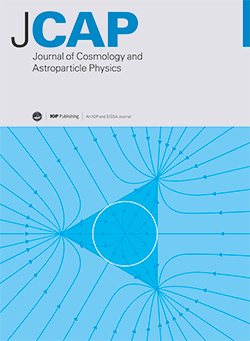Bracketing the soliton-halo relation of ultralight dark matter
IF 5.3
2区 物理与天体物理
Q1 ASTRONOMY & ASTROPHYSICS
Journal of Cosmology and Astroparticle Physics
Pub Date : 2025-06-23
DOI:10.1088/1475-7516/2025/06/050
引用次数: 0
Abstract
In theories of ultralight dark matter, solitons form in the inner regions of galactic halos. The observational implications of these depend on the soliton mass. Various relations between the mass of the soliton and properties of the halo have been proposed. We analyze the implications of these relations, and test them with a suite of numerical simulations. The relation of Schive et al. 2014 is equivalent to (E/M)sol = (E/M)halo where Esol(halo) and Msol(halo) are the energy and mass of the soliton (halo). If the halo is approximately virialized, this relation is parametrically similar to the evaporation/growth threshold of Chan et al. 2022, and it thus gives a rough lower bound on the soliton mass. A different relation has been proposed by Mocz et al. 2017, which is equivalent to Esol = Ehalo, so is an upper bound on the soliton mass provided the halo energy can be estimated reliably. Our simulations provide evidence for this picture, and are in broad consistency with the literature, in particular after accounting for ambiguities in the definition of Ehalo at finite volume.涵盖了超轻暗物质的孤子-光晕关系
在超轻暗物质理论中,孤子形成于星系晕的内部区域。它们的观测意义取决于孤子的质量。人们提出了孤子质量与光晕性质之间的各种关系。我们分析了这些关系的含义,并用一组数值模拟对它们进行了测试。Schive et al. 2014的关系式等价于(E/M)sol = (E/M)晕,其中Esol(晕)和Msol(晕)分别是孤子(晕)的能量和质量。如果晕被近似地虚化,这种关系在参数上与Chan et al. 2022的蒸发/生长阈值相似,因此它给出了孤子质量的粗略下界。Mocz等人(2017)提出了一个不同的关系式,它等价于Esol = Ehalo,因此在能够可靠地估计晕能量的情况下,这是孤子质量的上界。我们的模拟为这一图景提供了证据,并且与文献广泛一致,特别是在考虑了有限体积下Ehalo定义的模糊性之后。
本文章由计算机程序翻译,如有差异,请以英文原文为准。
求助全文
约1分钟内获得全文
求助全文
来源期刊

Journal of Cosmology and Astroparticle Physics
地学天文-天文与天体物理
CiteScore
10.20
自引率
23.40%
发文量
632
审稿时长
1 months
期刊介绍:
Journal of Cosmology and Astroparticle Physics (JCAP) encompasses theoretical, observational and experimental areas as well as computation and simulation. The journal covers the latest developments in the theory of all fundamental interactions and their cosmological implications (e.g. M-theory and cosmology, brane cosmology). JCAP''s coverage also includes topics such as formation, dynamics and clustering of galaxies, pre-galactic star formation, x-ray astronomy, radio astronomy, gravitational lensing, active galactic nuclei, intergalactic and interstellar matter.
 求助内容:
求助内容: 应助结果提醒方式:
应助结果提醒方式:


